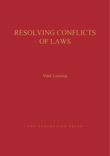Australian article round-up 2011: Conflicts within the Australian federation
Continuing the Australian article round-up, readers may be interested in the following article and recently published book raising points about conflicts within the Australian federation:
- Geoffrey Lindell and Sir Anthony Mason, ‘The Resolution of Inconsistent State and Territory Legislatoin’ (2010) 38 Federal Law Review 391:
[W]e have chosen to discuss an important aspect of the subject [of federalism] which has become even more important since the High Court recognised that State legislation is capable of operating beyond the territorial limits of the enacting State. That aspect is how conflicts are resolved between overlapping State and Territory civil and criminal legislation which is capable of operating beyond the territorial limits of the enacting State or Territory. Our aim is to identify the principles which govern, or should govern, the resolution of such conflicts. As will appear, the governing principles which we favour are as follows:
(1) a State (or Territory, if authorised by the Australian Parliament) can, subject to some limitations, legislate with extraterritorial effect in another State (or Territory); primacy will be accorded, in a case of direct or indirect inconsistency, to the law of the State (or Territory) legislature which has competence to legislate in the geographical area in which the law of the former State (or Territory) purports to operate (our ‘main solution’);
(2) the closer connection test suggested in Port MacDonnell Professional Fishermen’s Association Inc v South Australia (‘closer connection test’) applies only where the same inconsistency arises with respect to legislation which seeks to operate outside the geographical area of both the jurisdictions mentioned in the first principle, for example Australian offshore areas; and
(3) principles (1) and (2) only operate in the absence of uniform choice of law rules prescribed by federal legislation which displaces them.
An important feature in all legal systems, but especially in federations whose polities have overlapping legislative powers, is that those laws regularly conflict – or at least are claimed to conflict. Any coherent legal system must have principles for resolving such conflicts. Those principles are of immense practical as well as theoretical importance. This book, which straddles constitutional law and statutory interpretation, describes and analyses those principles.
This book does not merely address the conflicts between Commonwealth and State laws resolved by the Constitution (although it does that and in detail). It analyses the resolution of all of the conflicts of laws that occur in the Australian legal system: conflicts between laws enacted by the same Parliament and indeed within the same statute, conflicts between Commonwealth, State, Territory, Imperial laws and delegated legislation.
After identifying the laws in force in Australia, the chapters deal with:
- conflicts in laws made by the same legislature, focussing on the interpretative process of statutory construction;
- repugnancy, a doctrine with continuing vitality in the areas of s79 of the Judiciary Act, delegated legislation and Territory laws;
- conflicts between laws of the Commonwealth and State laws, proposing that the categories of inconsistency (commonly three: direct, indirect and ‘covering the field’) are best seen aspects of a single constitutional concept;
- conflicts between the laws of two States, and
- conflicts involving the laws of the self-governing Territories.



